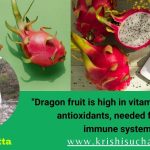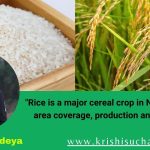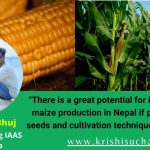INTEGRATED NUTRIENT MANAGEMENT (INM) OF CEREAL CROPS

Introduction:
Integrated nutrient management is the combined application of chemical fertilizers along with organic resource materials like organic manures, green manures, bi-fertilizers and other organic decomposable materials for crop production. IPNS is ecologically, socially and economically viable and environment friendly which can be practiced by farmers to derive higher productivity with simultaneously maintaining soil fertility. Integrated nutrient management encourages the use of on-farm organics, thus it saves on the cost of fertilizers for crop production. It involves proper combination of chemical fertilizers, organic manure, crop, residues, N2~fixing crops (like pulses such as rice bean, Black gram, other pulses and oilseeds such as soybean and bio-fertilizers suitable to the system of land use and ecological, social and economic conditions. The cropping system rather than an individual crop, and farming system rather than an individual field, is the focus of attention in this approach for development INM practices for various categories.
Principles Underlying INM System :
1. Nutrients removed by crops must be returned to the soil.
2. Soil physical conditions should be maintained and upgraded.
3. Organic carbon levels of soils should be maintained and enhanced.
4. Build-up of abiotic stress should be minimal.
5. Degradation of land occurring due to soil erosion must be controlled.
6. Soil quality with respect to soil acidity,salinity and sodicity or toxic elements build-up must be minimized.
Goals of INM:
To ensure productive and sustainable agriculture. To reduce expenditure on costs of purchased inputs by using farm manure and crop residue, etc. To utilize the potential benefits of green manures, leguminous crops and bio-fertilizers. To prevent degradation of the environment. To meet the social and economic aspiration of the farmers without harming the natural resource base of
agricultural production.
Nutrient Cycle:
Soil nutrient availability changes over time. The continuous recycling of nutrients into and out of the soil is known as the nutrient cycle . The cycle involves complex biological and chemical interactions, some of which are not yet fully understood. A simplified version of this cycle of plant growth, based on Smaling , is shown in Figure 1. The simplified cycle has two parts: “inputs” that add plant nutrients to the soil and “outputs” that export them from the soil largely in the form of agricultural products. Important input sources include inorganic fertilizers; organic fertilizers such as manure, plant residues, and cover crops; nitrogen generated by leguminous plants; and atmospheric nitrogen deposition. Nutrients are exported from the field through harvested crops and crop residues, as well as through leaching, atmospheric volatilization, and erosion.
Components Of INM:
Soil Source:
Mobilizing unavailable nutrients and to use appropriate crop varieties, cultural practices and cropping system.
Mineral Fertilizer :
Super granules, coated urea, direct use of locally available rock PO4 in acid soils, Single Super Phosphate (SSP), MOP and micronutrient fertilizers.
Organic Sources :
By products of farming and allied industries. FYM, droppings, crop waste, residues, sewage, sludge, industrial waste.
Biological Sources :
Microbial inoculants substitute 15 – 40 Kg N/ha
Advantages of Integrated Nutrient Management
INM enables the adaptation of plant nutrition and soil fertility management in farming systems to site characteristics, taking advantage of the combined and harmonious use of organic and inorganic nutrient resources to serve the concurrent needs of food production and economic, environmental and social viability. INM empowers farmers by increasing their technical expertise and decision-making capacity. It also promotes changes in land use, crop rotations, and interactions between forestry, livestock and cropping systems aspart of agricultural intensification and diversification.
Conclusions and Recommendations :
Agriculture remains a soil-based industry, there is no way that required yield increases of the major crops can be attained without ensuring that plants have an adequate and balanced supply of nutrients. The appropriate environment must exist for nutrients to be available to a particular crop in the right form, in the correct absolute and relative amounts, and at the right time for high yields to be realized in the short and long term. Successful integrated nutrient and soil fertility management depends on a concerted effort by a multitude of actors. Similar complexity will characterize the response of research and extension organizations and the building of institutions that stress the participation of smallholder farmers, the private sector, the public sector, and NGOs. Success will ultimately depend on how well these complex actions and socioeconomic factors can increase crop yields in a sustainable manner and improve the food security of millions of smallholder farmers currently struggling with declining soil fertility and poor management of plant nutrients.
Writer: Aakash Acharya (Student, Bsc. Ag IAAS Paklihawa Campus)

 दिल्लीको होटलमा बसेर क्यानडा र अमेरिकामा मानव तस्करी
दिल्लीको होटलमा बसेर क्यानडा र अमेरिकामा मानव तस्करी  अनलाइन जुवा खेलाएर काभ्रेका अनिलले गरे दुई अर्बको कारोबार
अनलाइन जुवा खेलाएर काभ्रेका अनिलले गरे दुई अर्बको कारोबार  मुख्यमन्त्री सोडारीले विश्वासको मत लिन सुदूरपश्चिमको प्रदेश सभा बैठक आव्हान
मुख्यमन्त्री सोडारीले विश्वासको मत लिन सुदूरपश्चिमको प्रदेश सभा बैठक आव्हान  अफगानिस्तानमा बाढीबाट ३१५ भन्दा बढीको मृत्यु
अफगानिस्तानमा बाढीबाट ३१५ भन्दा बढीको मृत्यु  सुँगुरको मिर्गौला प्रत्यारोपण गरिएका रिचर्डको निधन
सुँगुरको मिर्गौला प्रत्यारोपण गरिएका रिचर्डको निधन 


